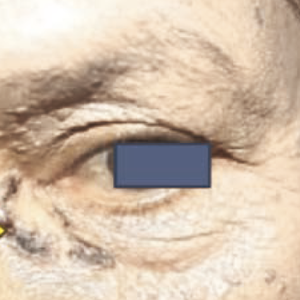Resolving trapdoor phenomenon without secondary procedure after forehead flap on medial canthal region

All claims expressed in this article are solely those of the authors and do not necessarily represent those of their affiliated organizations, or those of the publisher, the editors and the reviewers. Any product that may be evaluated in this article or claim that may be made by its manufacturer is not guaranteed or endorsed by the publisher.
Authors
Herein, we present a case of basal cell carcinoma in a 59-yearold woman. It presented with painless itchy, black, gradually enlarged patches which were easily bled under her left eye since three years ago. A dermatological examination of the left medial canthus region obtained hyperpigmented plaques (2x0.8x0.1 cm) with uneven skin texture, irregular borders, and erosion on the center of the lesion. We performed forehead flap technique surgery followed by eight-month monitoring, resulting in a satisfying outcome in both function and appearance. The thinning technique and adjusting the flap size from the forehead area to the medial canthus should be as thin as possible to avoid differences in skin thickness and post-reconstruction hypertrophic scars. A bulging appears on the surgical site a month after the procedure, known as the trapdoor phenomenon, on the 8th month of followup, the trapdoor phenomenon disappeared.
How to Cite

This work is licensed under a Creative Commons Attribution-NonCommercial 4.0 International License.








